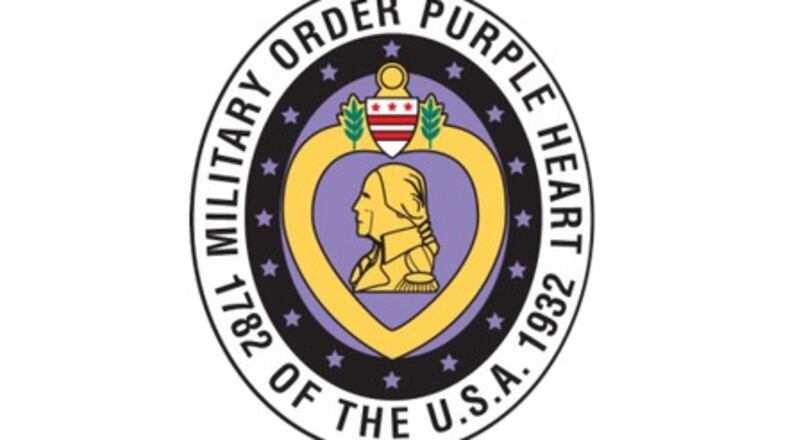Sherman and Randy Howson, Purple Heart Trail coordinator for Ohio, will serve as the ceremony’s speakers. Master Sgt. Benjamin Seekell, a Purple Heart recipient and the 88th Medical Operations Squadron first sergeant, is slated as the ceremony’s emcee.
“It’s an honor to be part of this history and to take part in the legacy that it will leave behind for future generations of warfighters,” said Seekell in reference to participating in the first active-duty base’s designation ceremony. “I’m proud to be counted amongst those who have been willing to sacrifice.”
Sacrifice is something that both service members and Purple Heart recipients know and share other than their service. Although they both have served and sacrificed, those who have earned and have been awarded the military’s oldest decoration still in use made an additional sacrifice.
Per current regulations, in order for the Purple Heart to be awarded to someone, the person must have served with one of the U.S. Armed Services’ branches after April 5, 1917, and also been wounded, killed or died from a wound sustained as a result of military operations while on a peacekeeping mission outside of the U.S. and its territories.
The Purple Heart was derived from a military merit award that Gen. George Washington established in 1782. The Continental Congress’ general was unable to recognize his enlisted soldiers’ merits with promotions or commissions, so he created the Honorary Badge of Distinction or the Badge of the Military Merit. Those who received that honor were listed in a “Book of Merit” and were given a distinction similar to officers when it came to passing guards and sentinels.
The three known recipients of the Badge of the Military Merit were Sgts. Elijah Churchill, William Brown and Daniel Bissel. The Badge of Merit was not used again after the American Revolutionary War.
In 1932, the Badge of Merit was revived and transformed into today’s Purple Heart. It was designed to continue Washington’s desire to recognize merit and honor the first president’s memory and achievements as initially stated in the War Department General Orders No. 3.
According to Executive Order 11016, “WHEREAS General George Washington, at Newburg-on-the-Hudson, on August 7, 1782, during the War of the Revolution, issued an Order establishing the Honorary Badge of Distinction, otherwise known as the Badge of Military Merit or Decoration of the Purple Heart; and “WHEREAS the award of the decoration ceased with the closing of the War of the Revolution and was revived on February 22, 1932, out of respect to the memory and military achievements of General George Washington, by War Department General Orders No. 3 …”
While the War Department General Order No. 3 birthed today’s Purple Heart, Executive Order 11016 is one of four executive orders and several U.S. codes and public laws that authorizes award of the Purple Heart to service members.
The Purple Heart has undergone several changes since its creation, but its intention to recognize the merit and honor of the service members it’s awarded to has not.
“My hope is to continue bringing awareness to our service members and citizens that the Purple Heart is affixed to real people who willingly incurred great physical and mental harm for the furtherance of our way of life,” said Seekell.
Therefore, on Dec. 10, when Wright-Patterson becomes designated as a Purple Heart Base and joins the Purple Heart Trail community, it will be part of a community designed to bring awareness to the sacrifices of Purple Heart recipients.
Howson said the Purple Heart Trail is a silent and visual way to say thank you to Purple Heart recipients for their sacrifices.
He added that a lot of veterans are not seeking attention from people to make a big deal about their sacrifices. But when recipients see the Purple Heart signs showing support for them, they do appreciate it.
The Purple Heart Trail is a collection of communities across the nation that have sought designation as Purple Heart cities and states, along with bridges, highways, roads and monuments that are designated or created to honor Purple Heart recipients. It serves as a visual reminder that even though people may not know each recipient’s name or sacrifice, there are people in this country who appreciate the sacrifices made by the recipients and know it’s because of them and people like them that this country continues to be great.
“It’s a tale of honor,” said Seekell. “We stand here because of the heroics of others. We stand on the shoulders of giants, without whom we would not exist as we do today.
“[Lastly,] it shows that we remember [and] understand above all what it takes to be free,” added Seekell.
For more information about the designation ceremony, call the 88ABW Public Affairs office at 937-522-3252. You can go to the Military Order of the Purple Heart's website, www.purpleheart.org , for more information about the Purple Heart Trail. To learn more about registered Purple Heart recipients, visit the National Purple Heart Hall of Honor's website: www.thepurpleheart.com.
About the Author
